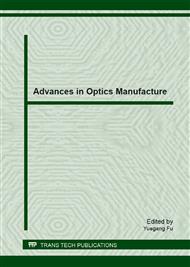p.21
p.27
p.33
p.38
p.44
p.52
p.57
p.64
p.69
Target Optimization Design of Cam Curve in Zoom System
Abstract:
Zoom lens has been widely applied in all kinds of fields, and its cam optimization is the key to actualizing the performance of its optical design and the zooming process, while the smoothness and speediness of zooming movement must be considered for military and civilian use. With the incremental use of environmental requirements, it puts forward higher requests to the cam performance of lens. In order to guarantee that the cam has good stiffness in the case of vibration and shock environment, in the process of cam design, it not only requires curve optimal, but also needs to consider influence on the performance which is caused by reduced cam stiffness of the zoom system. A fine curve can ensure that the cam pressure angle α is smaller, and to ensure the cam follower maintains the uniform velocity and smaller acceleration in zooming process, and make the zoom system produce little impact, and whole zooming process smooth and fluent, it can reduce the zoom systems driving moment M, and can ensure the stability imaging of the zoom system. Good cam stiffness K can make the zoom lens have good stability in vibration environment, and make sure that the image quality. M and K respectively up to the pressure angle α of zoom curve and the rotation angle θ of zoom curve in cam. In the new cam design process, considering the whole influence on the performance that is caused by K and M to cam, we construct the function expressions K = f (α, θ) and M = f (α, θ), and then, build target optimization function with K and M, optimize the relationship between pressure angle α of zoom curve and rotation angle θ, looking for the optimal value for the stiffness K and the cam system driving moment M , and improve overall performance of the zoom cam .
Info:
Periodical:
Pages:
44-51
Citation:
Online since:
May 2013
Authors:
Keywords:
Price:
Сopyright:
© 2013 Trans Tech Publications Ltd. All Rights Reserved
Share:
Citation:


